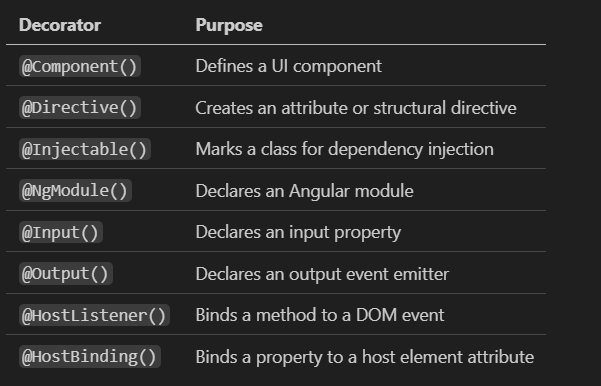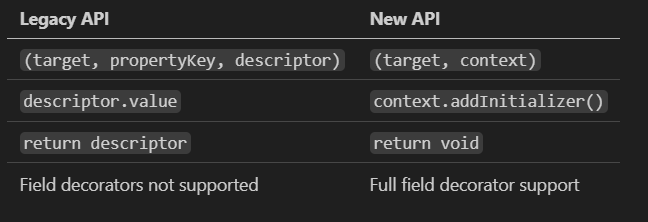Dev 101: TypeScript 5.0+ Decorators
1. Foundation: The Decorator Pattern
The Decorator Pattern is a structural design pattern that attaches new behaviors to objects by placing them inside special wrapper objects, called decorators. This allows you to add functionality without modifying the original class. Go straight to the code [github repo]
// Classical Decorator Pattern Example
class Coffee {
cost() { return 5; }
}
class MilkDecorator {
constructor(private coffee: Coffee) {}
cost() { return this.coffee.cost() + 1; }
}
const milkCoffee = new MilkDecorator(new Coffee());
console.log(milkCoffee.cost()); // 6
TypeScript 5.0+ decorators are inspired by this concept: they let you add behavior or metadata to classes, methods, and properties in a declarative, compile-time manner.
In Typescript versions lesser than 5.0, decorators have a different implementation. Here is the link to an article covering lower versions: Typescript Decorators (Pre-v5.0)
TypeScript for a while had support for "experimental" decorators for years. While these experimental decorators have been incredibly useful, they modeled a much older version of the decorators proposal, and always required an opt-in compiler flag called
--experimentalDecorators. Any attempt to use decorators in TypeScript without this flag used to prompt an error message.According to this announcement,
--experimentalDecoratorswill continue to exist for the foreseeable future; however, without the flag, decorators will now be valid syntax for all new code. Outside of--experimentalDecorators, they will be type-checked and emitted differently. The type-checking rules and emit are sufficiently different that while decorators can be written to support both the old and new decorators behavior, any existing decorator functions are not likely to do so.
2. TypeScript 5.0+ Decorators: Basics & Parameters
To use the new decorator API in TypeScript 5.0+, configure your tsconfig.json:
{
"target": "ESNext",
"module": "ESNext",
"experimentalDecorators": true,
"useDefineForClassFields": true
}
2.1 Types of Decorators & Their Parameters
Parameter Details
Class Decorator: Receives the class constructor and returns it (or a new constructor).
Field Decorator: Receives a context object and returns a function that processes the field value.
Method Decorator: Receives a context object and can use
addInitializerto modify the method.Accessor Decorator: Receives a context object for getter/setter methods.
// New API Examples
function MyClassDecorator<T extends new (...args: any[]) => any>(constructor: T): T {
console.log('Class created:', constructor.name);
return constructor;
}
function MyFieldDecorator<T extends object, K extends keyof T>(
target: undefined,
context: ClassFieldDecoratorContext<T, T[K]>
): (value: T[K]) => T[K] {
return (value: T[K]) => value;
}
function MyMethodDecorator<T extends object>(
target: undefined,
context: ClassMethodDecoratorContext<T, (this: T, ...args: any[]) => any>
): void {
context.addInitializer(function (this: T) {
// Modify the method here
});
}
Example Recap:
class Example {
@MyFieldDecorator
someProperty: string = "hello";
@MyMethodDecorator
someMethod(msg: string) {}
}
Decorators execute at compile/design time. You can modify behavior or attach annotations used by frameworks.
3. Reflection & Metadata
To read design-time types at runtime, use reflect-metadata:
Install:
npm install reflect-metadataImport once:
import 'reflect-metadata';Enable
emitDecoratorMetadataintsconfig.json.
// Retrieve the type of a property
Reflect.getMetadata('design:type', target, propertyKey);
Reflection lets decorators inspect types, useful for form builders, DI, or validation.
4. Angular Built-in Decorators
Angular started using decorators long before TC39 finalized the spec — and relied on TypeScript’s experimental decorators. Although under the hood Angular relies on TypeScript’s standard compiler, it has its own Angular compiler (ngc) that processes the decorators and generates code for templates, DI, etc. See The Dance of Decorated Classes: Inside the Angular Compiler. Hence,
ngccan be said to be an extension TypeScript compiler which knows how to “execute” Angular decorators, applying their effects to the decorated classes at build time.
5. Writing Custom Decorators (New API)
5.1 Class Decorator
function LogClass<T extends new (...args: any[]) => any>(constructor: T): T {
console.log('Class created:', constructor.name);
return constructor;
}
@LogClass
class MyService {}
5.2 Method Decorator
function LogMethod<T extends object>(
target: undefined,
context: ClassMethodDecoratorContext<T, (this: T, ...args: any[]) => any>
): void {
const methodName = context.name;
context.addInitializer(function (this: T) {
const originalMethod = this[methodName as keyof T] as (this: T, ...args: any[]) => any;
(this as any)[methodName] = function (this: T, ...args: any[]) {
console.log(`Calling ${String(methodName)} with`, args);
return originalMethod.call(this, ...args);
};
});
}
5.3 Field Decorator
function DefaultValue<T extends object, K extends keyof T>(
defaultValue: T[K]
) {
return function (
target: undefined,
context: ClassFieldDecoratorContext<T, T[K]>
): (value: T[K]) => T[K] {
return (value: T[K]) => value ?? defaultValue;
};
}
class Example {
@DefaultValue("hello")
message: string;
}
5.4 Accessor Decorator
function Validate<T extends object>(
target: undefined,
context: ClassAccessorDecoratorContext<T, any>
): void {
context.addInitializer(function (this: T) {
const originalGet = this[context.name as keyof T] as any;
const originalSet = context.access.set;
context.access.set = function (value: any) {
if (value === undefined || value === null) {
throw new Error(`${String(context.name)} cannot be null or undefined`);
}
originalSet.call(this, value);
};
});
}
6. Decorator Factories & Composition
6.1 Decorator Factories
A decorator factory is a function that returns a decorator, allowing you to pass arguments/configuration.
function LogWithPrefix(prefix: string) {
return function <T extends object>(
target: undefined,
context: ClassMethodDecoratorContext<T, (this: T, ...args: any[]) => any>
): void {
const methodName = context.name;
context.addInitializer(function (this: T) {
const originalMethod = this[methodName as keyof T] as (this: T, ...args: any[]) => any;
(this as any)[methodName] = function (this: T, ...args: any[]) {
console.log(`${prefix}: ${String(methodName)}`, args);
return originalMethod.call(this, ...args);
};
});
};
}
class Example {
@LogWithPrefix('DEBUG')
say(message: string) {
console.log(message);
}
}
6.2 Decorator Composition
Decorator composition means stacking multiple decorators on a single target. Decorators are applied bottom to top (the last decorator in code is applied first).
function Log<T extends object>(
target: undefined,
context: ClassMethodDecoratorContext<T, (this: T, ...args: any[]) => any>
): void {
const methodName = context.name;
context.addInitializer(function (this: T) {
const originalMethod = this[methodName as keyof T] as (this: T, ...args: any[]) => any;
(this as any)[methodName] = function (this: T, ...args: any[]) {
console.log('Calling', String(methodName));
return originalMethod.call(this, ...args);
};
});
}
function Cache<T extends object>(
target: undefined,
context: ClassMethodDecoratorContext<T, (this: T, ...args: any[]) => any>
): void {
const methodName = context.name;
const cache = new Map<string, any>();
context.addInitializer(function (this: T) {
const originalMethod = this[methodName as keyof T] as (this: T, ...args: any[]) => any;
(this as any)[methodName] = function (this: T, ...args: any[]) {
const cacheKey = JSON.stringify(args);
if (cache.has(cacheKey)) {
return cache.get(cacheKey);
}
const result = originalMethod.call(this, ...args);
cache.set(cacheKey, result);
return result;
};
});
}
class MathService {
@Log
@Cache
expensiveOperation(x: number) {
return x * x; // pretend this is slow
}
}
7. Real-World Use Cases
7.1 Permission Check
function RequirePermission(permission: string) {
return function <T extends object>(
target: undefined,
context: ClassMethodDecoratorContext<T, (this: T, ...args: any[]) => any>
): void {
const methodName = context.name;
context.addInitializer(function (this: T) {
const originalMethod = this[methodName as keyof T] as (this: T, ...args: any[]) => any;
(this as any)[methodName] = function (this: T, ...args: any[]) {
const svc = inject(PermissionService);
if (!svc.hasPermission(permission)) {
throw new Error(`Missing ${permission}`);
}
return originalMethod.call(this, ...args);
};
});
};
}
7.2 Caching
const cache = new Map<string, any>();
function CacheResult<T extends object>(
target: undefined,
context: ClassMethodDecoratorContext<T, (this: T, ...args: any[]) => any>
): void {
const methodName = context.name;
context.addInitializer(function (this: T) {
const originalMethod = this[methodName as keyof T] as (this: T, ...args: any[]) => any;
(this as any)[methodName] = function (this: T, ...args: any[]) {
const ckey = `${String(methodName)}-${JSON.stringify(args)}`;
if (cache.has(ckey)) return cache.get(ckey);
const res = originalMethod.call(this, ...args);
cache.set(ckey, res);
return res;
};
});
}
7.3 Analytics on Component Init
function WithAnalytics(eventName?: string) {
return function <T extends new (...args: any[]) => any>(constructor: T): T {
const originalInit = constructor.prototype.ngOnInit;
constructor.prototype.ngOnInit = function () {
const analytics = inject(AnalyticsService);
analytics.trackEvent('Init', { name: eventName || constructor.name });
originalInit?.apply(this);
};
return constructor;
};
}
7.4 Auto-Unsubscribe
function AutoUnsubscribe<T extends new (...args: any[]) => any>(constructor: T): T {
const originalDestroy = constructor.prototype.ngOnDestroy;
constructor.prototype.ngOnDestroy = function () {
for (const k in this) {
this[k]?.unsubscribe?.();
}
originalDestroy?.apply(this);
};
return constructor;
}
8. Bonus: Simple Signals & Observables
Bonus Simple Signal inspired by Angular Signal and a custom fromObservable you can use to try out the @AutoUnsubscribe.
8.1 SimpleSignal
function SimpleSignal<T>(initial: T) {
let value = initial;
const listeners: (() => void)[] = [];
const signal = (() => value) as (() => T) & {
set: (v: T) => void;
effect: (fn: () => void) => void;
};
signal.set = v => { value = v; listeners.forEach(fn => fn()); };
signal.effect = fn => { listeners.push(fn); fn(); };
return signal;
}
8.2 fromObservable
import { Observable } from 'rxjs';
function fromObservable<T>(obs$: Observable<T>, initial: T) {
const sig = SimpleSignal(initial);
const sub = obs$.subscribe(val => sig.set(val));
(sig as any).unsubscribe = () => sub.unsubscribe();
return sig;
}
9. Code Lab: Debounce Decorator
Objective: Create a @Debounce method decorator that delays method execution.
function Debounce(ms: number) {
return function <T extends object>(
target: undefined,
context: ClassMethodDecoratorContext<T, (this: T, ...args: any[]) => any>
): void {
const methodName = context.name;
let timeoutId: NodeJS.Timeout;
context.addInitializer(function (this: T) {
const originalMethod = this[methodName as keyof T] as (this: T, ...args: any[]) => any;
(this as any)[methodName] = function (this: T, ...args: any[]) {
clearTimeout(timeoutId);
timeoutId = setTimeout(() => {
originalMethod.call(this, ...args);
}, ms);
};
});
};
}
Usage:
class SearchComponent {
@Debounce(300)
onSearch(query: string) {
// This will only execute after 300ms of no calls
}
}
10. Migration from Legacy API
Key Differences:
Migration Example:
Legacy:
function LogMethod(target: any, propertyKey: string, descriptor: PropertyDescriptor) {
const original = descriptor.value;
descriptor.value = function (...args: any[]) {
console.log(`Calling ${propertyKey}`, args);
return original.apply(this, args);
};
return descriptor;
}
New API:
function LogMethod<T extends object>(
target: undefined,
context: ClassMethodDecoratorContext<T, (this: T, ...args: any[]) => any>
): void {
const methodName = context.name;
context.addInitializer(function (this: T) {
const originalMethod = this[methodName as keyof T] as (this: T, ...args: any[]) => any;
(this as any)[methodName] = function (this: T, ...args: any[]) {
console.log(`Calling ${String(methodName)}`, args);
return originalMethod.call(this, ...args);
};
});
}
11. Best Practices & Summary
Keep decorators small and single-purpose
Prefer decorator factories for configurability
Document execution order if it matters
Understand evaluation and application order: decorators are applied bottom-to-top
Use reflection for advanced scenarios (type inspection, DI, validation)
Leverage composition to separate concerns and reuse logic
Use the new API for TypeScript 5.0+ projects
Consider migration from legacy API for better performance and features
🎉 You now have a complete advanced reference for TypeScript 5.0+ decorators, including real-world use cases, composition, and migration guidance.




